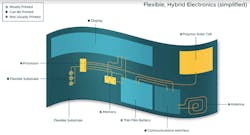The need for durability in the field versus mechanical shock and vibration is clear for many electronic devices, and flexibility built into components such as power supplies and display screens can make a difference in operating lifetimes for many devices. NextFlex is pursuing the development of flexible hybrid electronics (FHE) rather than conventional flexible circuits, with FHE combining printed circuits and components with discrete devices, such as silicon CMOS-based microprocessors and memory (see the figure). FHE technology is a viable candidate for many different types of wearable military electronic health monitors. It is also projected to have tremendous potential for a wide range of commercial electronic applications.
Phase is an important electrical parameter in many military electronic systems, and the phase behavior of FHE-based designs must be studied before the technology can be applied to critical electronic designs. The phase will vary with flexure but, by combining rigid integrated circuits (ICs) and printed circuits on flexible substrates, it is hoped that variations can be minimized and that FHE technology can be applied extensively to durable military electronic devices.
The NextFlex Manufacturing Innovation Institute works with the U.S. Army Combat Capabilities Development Command’s Army Research Laboratory (ARL) and entered into a second cooperative agreement with the U.S. Air Force Research Laboratory (AFRL). As part of the agreements, NextFlex attempts to commercialize FHE prototype circuits developed for the military as part of efforts to establish U.S. leadership in the technology.
“Flexible hybrid electronics is a new way to manufacture electronics that brings together digital additive manufacturing with traditional electronic components,” said Dr. Eric Forsythe, an Army physicist and government program manager for NextFlex. The FHE technology is projected to provide many advantages for future communications and sensor designs in command, control, communication, computers, cyber, intelligence, surveillance, and reconnaissance (C5ISR) systems.

